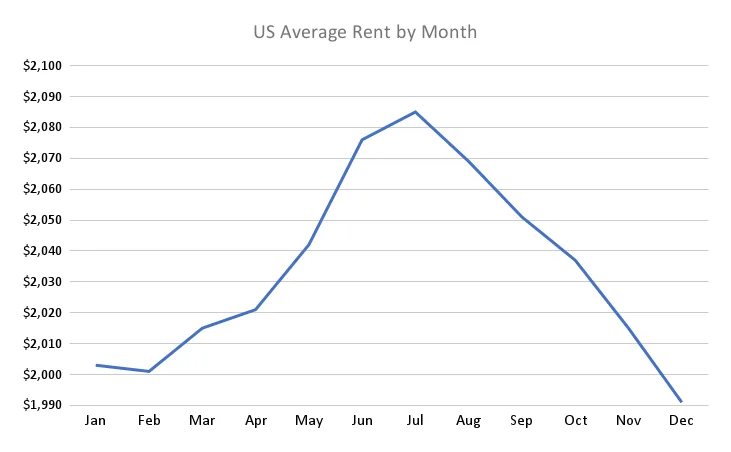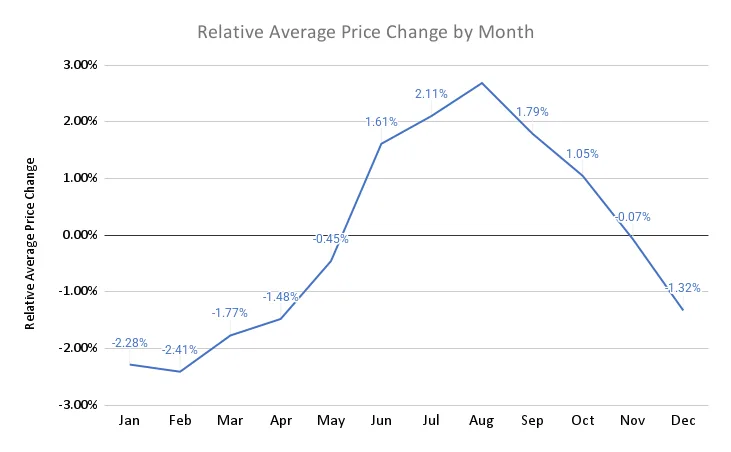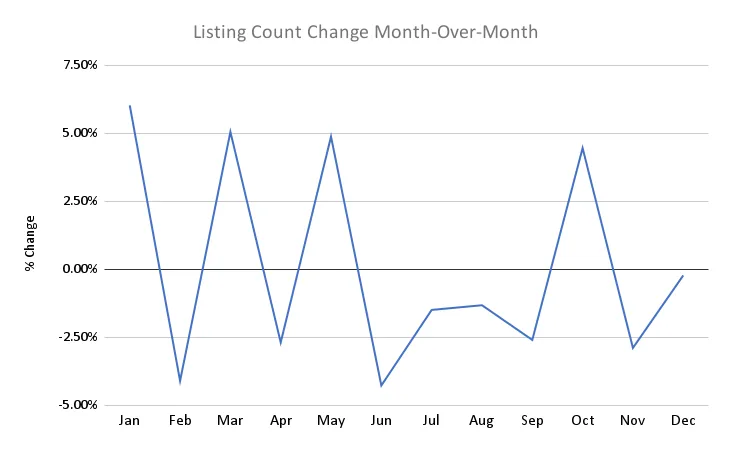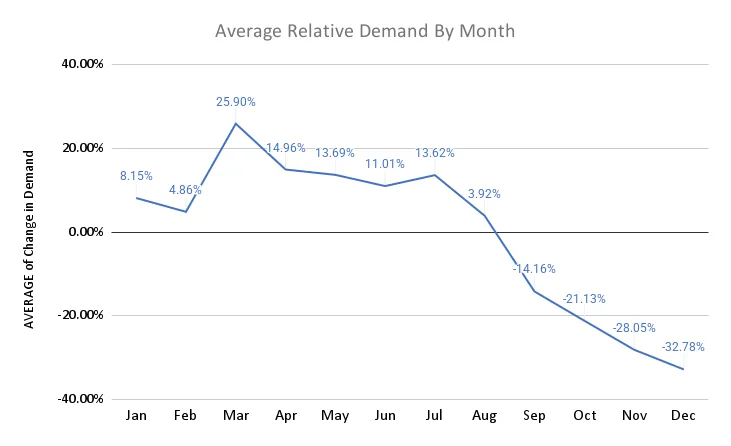When’s the best time of year to rent? TL;DR
Based on Zumper’s internal rent, search, and inventory data, the best time to find an apartment is from October to February, when demand is lowest and rent prices are significantly cheaper than in the summer—up to 9% in some markets.
If you want the least competition, October through December is the ideal time. This is when there are fewer interested renters for each available apartment.
If you want the cheapest rent, look in December through February.
Here’s what we’ll cover in this article:
- Rent price changes by season
- Cheapest time of year to rent
- Apartment listing availability by season
- Apartment search competition by season
- The best time of year to rent
- Cities with the largest rent increases in the summer
- Cities with the steadiest year-round rent
- Cities with the biggest winter discounts
- What seasonal trends mean for when you should start your apartment search
Are apartment rents seasonal? Yes—here’s when and why
Zumper’s internal pricing data shows that rent prices consistently peak in the summer—especially in July and August—and tend to drop during the winter months. This makes summer the most competitive (and costly) time to rent.

Over the past several years, average U.S. rent prices have increased by up to 2–3% during the summer compared to the annual average. For a renter paying $2,000/month, that’s an extra $40–$60 per month—or over $700 a year.
When is the cheapest time of year to rent an apartment?
December and February are consistently the cheapest months to rent nationwide. In fact, average rents in December are roughly 4.5% lower than in July, based on Zumper data from 2019 to 2024.
So, if cost is your top priority? Start your search in late fall or early winter.

When are the most apartment listings available?
Looking for the broadest selection without sacrificing rent cost? Search in March or May — this is when listings increase the most, and prices haven’t hit their peak.

Summer is still peak moving season. School is out, college grads are relocating, and job changes often occur. In cities with large student populations or seasonal employment, these shifts lead to huge waves of move-outs and move-ins.
As more people move, more listings become available, and demand increases. Our data shows that relative demand begins to take off in the spring, when people start to think about moving and begin looking for apartments casually, and increases most significantly by around 38% cumulatively during the summer months (May through July).

So while you’ll have more options, you’ll also face more competition. Landlords are less likely to negotiate rent, and listings go fast.
What month has the least apartment competition?
The months with the least competition would be the fall months: October, November, and December. These see the least competition compared to other months of the year. This is when demand has declined, but listings have not at the same rate.
By September, demand drops. This drop continues through the fall and bottoms out in November and December, when apartment searches are at their lowest point of the year.
Fewer people moving means:
- Less competition for listings
- More potential negotiating power with landlords
- Faster approval processes
In other words, if you want a calmer search process, winter is your season.
So, what time of year should I look for an apartment?
Every renter’s situation is different. Here’s how to time your search depending on your top priority:
| Priority | Best Time to Search | Why |
| Cheapest Rent | Dec—Feb | Lowest average rent, lowest demand |
| Most Listings | Apr—June | Peak inventory and turnover |
| Lowest Competition | Oct—Jan | Ratio of demand to available listings is lowest |
Which cities have the most seasonal rent changes?
While the national pattern holds true, rent seasonality is more pronounced in certain cities than others. Zumper’s data highlights markets where rent spikes in the summer and drops in the winter, and others where prices remain fairly stable year-round.
Cities with the biggest summer price increases
These cities experience the steepest seasonal rent hikes compared to their winter prices:
- Spokane, WA: +8.6% summer increase
- Syracuse, NY: +8%
- Glendale, AZ: +7%
- Cleveland, OH: +7%
- Winston-Salem, NC: +6.5%
- Reno, NV: +6.5%
- Boise, ID: +6%
- Chicago, IL: +6%
- Durham, NC: +6%
- New York, NY: +6%
Many of these cities have cold winters and strong school calendars, which cause demand to pile up in summer. If you’re renting in one of these metros, you can save hundreds by waiting until winter. In most places above, the average difference in dollar amount, is over $100 a month.
Cities with the steadiest year-round rent
If you live in one of these cities, timing your search matters less. That gives you more flexibility to rent when it suits your lifestyle.
These ten locations have less than a 1% change on average seasonally:
- Fort Worth, TX
- Average annual rent: $1,715
- Milwaukee, Wisconsin
- Average annual rent: $1,298
- Des Moines, IA
- Average annual rent: $1,104
- Richmond, VA
- Average annual rent: $1,441
- San Antonio, TX
- Average annual rent: $1,466
- Kansas City, MO
- Average annual rent: $1,271
- Buffalo, NY
- Average annual rent: $1,320
- Wichita, KS
- Average annual rent: $939
- Houston, TX
- Average annual rent: $1,619
- Louisville, KY
- Average annual rent: $1,333
In these locations, many in southern or warmer climates (but not all), rent prices don’t swing as much throughout the year, so you are less likely to run into massive rent spikes in particular seasons.
Cities with the biggest winter discounts
Want a deal? Rent in winter in these metros, where prices drop the most significantly from average:
- Syracuse, NY: Winter rent prices average around $1,195 (for all sizes)
- Spokane, WA: Winter rent average: $1,315
- Madison, WI: $1,519
- Cleveland, OH: $1,301
- Glendale, AZ: $1,631
- Winston-Salem, NC: $1,202
- Chicago, IL: $2,039
- New York, NY: $3,623
- Boise, ID: $1,159
- St Louis, MO: $1,294
In cities where rent drops in the winter the most, especially in high-cost cities like New York, even a small winter discount can save you thousands annually.
How long before moving should you start looking for an apartment?
Another common question Zumper hears is: How far in advance should I start my search?
- In summer, listings move quickly. Start looking 60 days before your desired move-in date, and be prepared to apply within 1–2 days of touring.
- In winter, there’s less urgency. You can typically start looking 4–6 weeks out and have more time to negotiate or compare listings.
Regardless of when you begin your search, when you’re ready to move, be sure to set alerts and get prequalified in advance.
FAQs about whether rent is seasonal
Is rent always higher in the summer?
Usually, but not always. Based on Zumper’s data and the national rent index, summer tends to have higher prices in most U.S. markets. August is often the most expensive month in most major markets, and January is typically the cheapest, but there are some places—such as Tucson, AZ, and Tallahassee, FL—where rent is actually the highest in September.
Is winter really better for renters?
If you value price, flexibility, or less stress, then yes. Winter is ideal for budget-conscious or first-time renters.
Are there fewer listings in winter?
Yes. Inventory is lowest in November and December, but demand drops even more, so the ratio of listings to renters is actually better for you.
When should college students look?
If you’re in a college town, aim to start your search in March or April to secure a place for summer, or look about a month out from your fall start date.
Is it bad to move in the fall?
Not at all. October is a “sweet spot” month in most markets, with prices starting to drop while there are plenty of listings still available.
What’s the final verdict on the best time of year to rent an apartment?
There’s no single “perfect” time to rent. But Zumper’s internal data shows clear patterns that can guide your search:
- Winter = Deals
- Spring = Balance
- Summer = Options
- Fall = Less stress
Whether you’re relocating across the country or just across town, planning your move around these seasonal insights can help you save time, money, and headaches.
Rent data changes, too—get all the rent price updates and rental market trends in our monthly National Rent Report, where we analyze all the rent prices and trends from across the U.S from the previous four weeks. You can follow along each month here.
For rent data calculated on a 30-day rolling basis, check out our Rent Research hub.
And whenever you’re ready to start looking for a new apartment, Zumper is here to help—with real-time alerts, verified listings, monthly rent price tracking, budgeting tools, and more—all to help you rent more confidently and with more ease.
How we got this data
This analysis is based exclusively on Zumper’s internal platform data, supported in part by the Labor of Bureau Statistic National Rent Index data.
We analyzed five years of rent price, listing, and internal search data to calculate monthly, seasonal, and annual averages for US markets, and used those averages to calculate trend and variability (standard deviation). Demand seasonality is expressed relative to a yearly baseline, and competitiveness is a calculation based on renter interest and active listings. We evaluated the rate of change alongside relative changes (percent differences from a market’s annual average) to reduce scale effects and account for outliers. Routine cleaning (removing incomplete rows of data, etc) and multi-year averaging were used to smooth short-term noise. Results reflect Zumper activity and are descriptive, not predictive.



